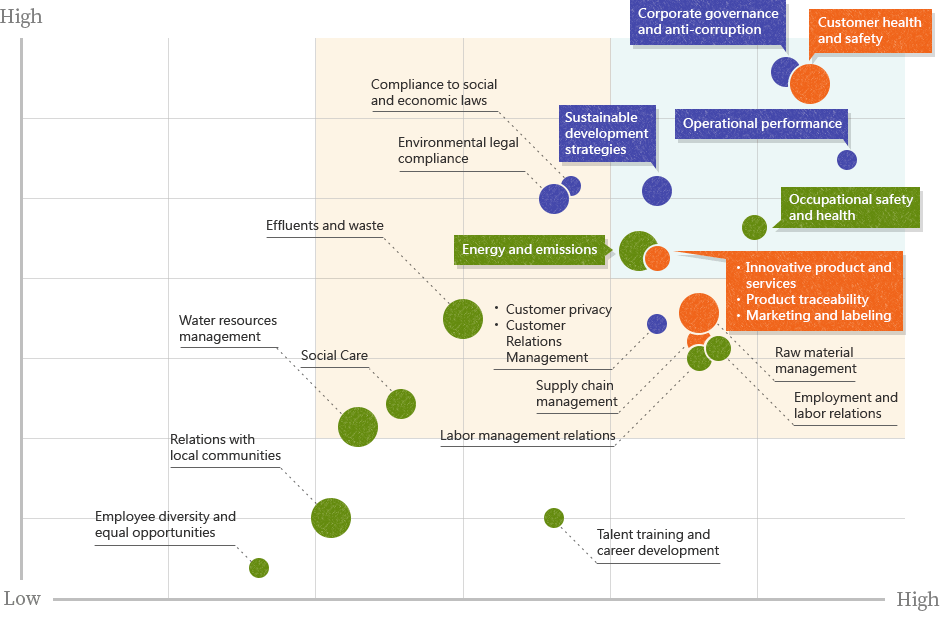Hsin Tung Yang implemented the material topic analysis to identify topics of concerns from different types of stakeholders, as well as to continuously improve our operating performance through effective communications with the stakeholders. Based on the principle of materiality from GRI Standards, we have established systematic processes to manage the material sustainable topics and goals, as well as to serve as the basis of preparing this Corporate Social Responsibility Report. Additionally, to comply with the stakeholders' request for Hsin Tung Yang's information disclosure in the Corporate Social Responsibility Report, we have conducted evaluations on three stages, "inspection and identification, "evaluation and prioritization," and "review and discussion."
01Inspection and
Identification
- Based on the GRI standards, recent trends from sustainable investment institutions DJSI and SASB, comparison results with industry benchmarks, and feedback from internal and external experts, 23 sustainable topics have been compiled as the basis for stakeholder evaluation.

02Evaluation and
Prioritization
- Twenty-eight surveys were collected for analysis based on the sustainable topics' levels of impact on Hsin Tung Yang's value chain, levels of influence over stakeholders' assessment and decision-making, and levels of impact on external economy, society, and environment.
- Materiality assessment and prioritization are carried out based on the levels of impact to Hsin Tung Yang from the analysis of survey results. A materiality matrix is drawn.

03Review and
Discussion
- Analysis result has identified 9 material topics and 10 secondary topics.
- The materiality matrix has been confirmed after reviews from supervisors of the CSR Team.
- This will be the basis of Hsin Tung Yang's CSR reporting framework and contents, and the management objectives over these 9 topics will be disclosed first.
Governance
Sustainable product and services
Environment and social
Material topics
Secondary topics

Level of influence on stakeholders' assessment and decision-making
Level of the topic's impact on Hsin Tung Yang's fulfillment of sustainable strategies
The levels of internal and external impact and influence of Hsin Tung Yang's material topics on the value chain, as well as the seven indicators of additional disclosure from listed food industry as requested by the Taiwan Stock Exchange, the GRI standards, management objectives, and corresponding chapter on performance and results, are organized in the following table.
| Material topics | Corresponding GRI theme | Internal boundaries | Critical stakeholders (●high level of impact / low level of impact○) | Management objectives and corresponding Chapter | |||||||||||
|---|---|---|---|---|---|---|---|---|---|---|---|---|---|---|---|
| Head office | Production plant | Stores | Other channels | Fund providers | Suppliers | Employee | Enterprise customers | Consumers | Government agencies | Assessment Department | Media | Communities and NGO | |||
| Sustainable management strategies | General disclosure: Strategies, Governance | △ | △ | △ | △ | ○ | ○ | ○ | ○ | ○ | ○ | Chapter 1 | |||
| Operational performance | Economic: Management performance | △ | △ | △ | △ | ● | ○ | ● | ● | ○ | Chapter 2 | ||||
| Corporate governance and anti-corruption | General disclosures: Organizational overview, Strategies, Ethics and integrity, Governance | △ | △ | △ | △ | ● | ○ | ● | ● | ○ | Chapter 2 | ||||
| Innovation in products and services | Economic: Anti-corruption Social: Customer health and safety | △ | △ | △ | △ | ● | ● | ● | Chapter 3 | ||||||
| Marketing and labeling | Social: Marketing and labeling | △ | △ | ● | ○ | ○ | Chapter 3 | ||||||||
| Customer health and safety | Social: Customer health and safety | △ | △ | △ | △ | ● | ○ | ○ | Chapter 3 | ||||||
| Product traceability | Social: Customer health and safety | △ | △ | △ | ● | ● | ○ | Chapter 3 | |||||||
| Energy and emissions | Environmental: Energy, Emissions | △ | △ | ○ | ● | ● | ○ | Chapter 4 | |||||||
| Occupational safety and health | Social: Occupational safety and health | △ | △ | △ | △ | ● | ○ | Chapter 5 | |||||||
Clear, Transparent & Well-rounded Processes
Are the Basis to Material Sustainable Topics



